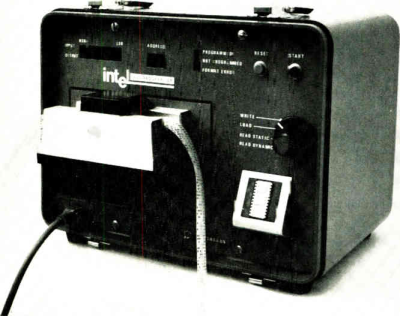An article on the history of EPROMs in the Soviet Union by [Vladimir Yakovlev] over at The CPU Shack Museum caught our attention. It is part one of a series on the topic, and walks you through the earliest Soviet EPROMs families.

The first of which, from the 1970s, is the K505RR1 developed and manufactured in Kyiv, equivalent to the first-generation Intel 1702A. It could hold 2048 bits, organized as 256×8, and offered a whopping 20 reprogramming cycles and data retention of 5000 hours.
The narrative proceeds to introduce several subsequent generations, design facilities, manufacturing techniques, and representative chip examples. A few tidbits — unlike Western EPROMs, the Soviets managed to put quartz windows in plastic packages (see the KP573 family).
In addition to the common gray or white, they also used different terracotta colored ceramic packages. An odd ceramic flat-pack EPROM is shown, and also some EPROMs whose dies have been painted over and re-badged as OTP chips.
Intel began producing EPROMs in 1971 as reported by the inventor, Intel’s Dov Frohman-Bentchkowsky, in Electronics Magazine’s 10 May edition (pg 91). We learned, amongst other things, that the 1701 did not have a quartz window, but could still be erased by exposure to X-rays. A friendly word of warning — browsing electronics advertisements from 50 years ago can easily consume your entire morning.
Once the package is sealed, information can still be erased by exposing it to X radiation in excess of 5×104 rads, a dose which is easily attainable with commercial X-ray generators.
To dig deeper, check out the CPU Shack’s write-up on the history of EPROMs in general, and a piece we wrote in 2014 about the history of home computers behind the Iron Curtain.
















In Soviet Russia, UV erases you!
I remember an old photograph of Soviet school kids, all wearing safety goggles, standing indoors around a UV light, presumably to get a “healthy” winter tan (perhaps in Siberia, or is Moscow far enough north?)
Kyiv. TIA.
Well, no. It was part of Soviet Union at the time, and that WAS the official name.
Nah it’s Keiv, FTFY
“Kyiv is the romanized official Ukrainian name for the city,[20][21] and it is used for legislative and official acts.”
https://en.wikipedia.org/wiki/Kyiv
In original article it reads as Kyiv:
[quote]
The first EPROM chip produced in the Soviet Union was the K505RR1, developed by the Kyiv Research Institute of Microdevices and manufactured by the Kvazar factory in Kyiv, Ukraine.
[/quote]
Typos should not be copied unless quoted.
Only chicken dishes are developed and manufactured in Kiev 😉
Thanks everyone for pointing this out. Initially I did a quick check on Wikipedia where I saw Kyiv was the Russian romanization and Kiev was the English name. I now realize that Kyiv seems to be the preferred English spelling these days. Also noticed that the New York Times uses Kyiv as well. Your corrections are noted and appreciated.
Chris, sorry but you’ve got it very wrong.
“Kyiv was the Russian romanization”
Nope, it’s the English version of the Ukranian name.
The Engish version of the Russian name is Kiev.
Furthermore the article may well be consdiered incorrect (by being politcally correct) as pretty much everything on the internet pre Russian invasion of Ukraine and comitting war crimes references the institute as:
Kiev Research Institute of Microdevices
This was its name under the SOVIET system. It doesn’t matter if it’s called Kyiv now, it’s what it was called back then. The institute would have been renamed post independance under Ukrainian law.
We might as well talk about “Saint Petersburg” a large city in the soviet union, again fundamentally wrong.
Revising historical facts to meet new politcal theory is entirely the wrong way to treat history
If we edit history how on earth can we expect to learn from it ??
Roald Dahl is also spinning in his grave about this entire woke subject as we speak
“the New York Times uses Kyiv as well.”
Right, it’s political.
Anyway, Kiev it is and will remain for me.
But more importantly, you exposed yourself as being easily lead by ‘managed media’ – so we are warned now.
It’s Kiev not Kyiv. Read more books. This is not Ukraine.
The X-ray erasing had a drawback – it would cause electromigration, crystal faults and other stuff in the EPROMs. This resulted into accelerated forgetting of them – they could lose data in matter of days. Someone suggested on internet it could be healed by putting them into high temperature for some time to let the silicon reorganize (or maybe to allow the dopants to make smooth gradients again?).
Though i wouldn’t bet on it – Soviet EPROMS were known for short lifespan and even my eastern-block voltmeter M1T330 has 3x 2708 – 2 of them are soviet and hold calibration data common to the whole series and 1 made by Texas Instruments which holds specific calibration data for the specific voltmeter.
Fab’ing reliable ”floating gates” without leakage is hard, even in the modern age. A customer of mine experienced two single-bit flips 3&4 years after I installed an interactive museum exhibit, one in our own FPGA configuration EEPROM and one in a COTS LCD panel—the display image literally flipped upside down, spontaneously! The customer was not happy. (and your flash thumb drives… not archival.)
> some EPROMs whose dies have been painted over and re-badged as OTP chips.
Reusing the die isn’t unusual. The expensive part is the window in the package. Most EPROM based chips like old PICs had cheaper OTP variants with the same die inside but just omitted the window.
Some time ago I read about EPROMs available in communist states – they were so bad that before programming there was check for bad memory locations and program was re-linked with empty spaces to omit them, for every single piece of equipment made with them